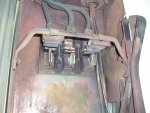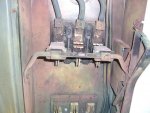You are using an out of date browser. It may not display this or other websites correctly.
You should upgrade or use an alternative browser.
You should upgrade or use an alternative browser.
Catastrophic Fuse Failures on Metal Halide Circuits
- Thread starter GotShocked
- Start date
- Status
- Not open for further replies.
hbiss
EC, New York NEC: 2017
- Location
- Little Falls, New York NEC: 2017
- Occupation
- EC
What precipitated these events? Was it a lamp or ballast failure, turn-on or turn- off or nothing?
-Hal
-Hal
Saturn_Europa
Senior Member
- Location
- Fishing Industry
- Occupation
- Electrician Limited License NC, QMED Electrician
Have you tested voltage and amps with the load on?
What do the contactors sound like? Any chatter?
Take apart affected contactors.
What do the contactors sound like? Any chatter?
Take apart affected contactors.
AKElectrician
Senior Member
- Location
- Soldotna, AK, USA
Strange both times same phase.
MTW
Senior Member
- Location
- SE Michigan
We are experiencing repeated failures of Littelfuse CCMR 30A fuses within lighting control panels that serve 1000W Metal Halide lighting circuits. See attached photo. The fuses appear to be properly sized for short circuit current, in-rush & continuous loads. We can find not evidence of water intrusion or rodent getting across the fuses or other causes. Any ideas? We are considering temporary resonance as a possibility?
From the photos provided, to me it looks like rupture from the available fault current at the location. Are these panels near a large service?
Taking a look at the let through current chart HERE and making an assumption that these controls are near a source of 20K available current.
Its not hard to see why some damage may be happening. The charts shows that for a 30A unit, the RMS let through fault current is 987A, with a 20,000A source. It's not hard to imagine a 30A CL CC fuse and block, having a hard time coping without some damage at those kinds of currents.
Once that fuse barrel ruptures and spews out a starting ball of plasma, the main 3Φ arc lights up across all phases. The fuses are closely spaced and are not enclosed. So their parts are fully available to the plasma ball, that is highly conductive, once it gets going.
In the first photo, every fuse and holder in the photo has some form of arc burn damage. Either on the fuse ferrules or the fuse clips. That's 5 fuses on each side of the one that ruptured. The the plasma ball was at least big enough to cover the width of 11 fuseblocks. At this point I would bet that the main feeding the controls would trip, hopefully. That's like a foot long ball of plasma, connected to the line side of 11 fuseblocks. The surrounding fuses contributed some of their load side current, until they also melted in the event.
In the second photo, even though it was the first in the row to rupture, the plasma ball still reached over 5 fuseholders to the right. The 5th one has burns on the upper clip. Looks pretty consistent in reach each time. Is that how many become engulfed before the main trips? I can't envision any good reason for it to go out, limiting itself to 5 holders, without the main putting it out.
Looks like you have #3/0 feeder cable, 200A, 277/480V and the loads are connected line to line, with no neutral used. That size cable can provide some serious arc power when connected close to a decent sized service.
Here is what I'm talking about, same cable size, same type conditions. Arc starting on the line side. Line to line fault, before the fuses.
You can see here that even the load side bus burned away. The enclosure sheet metal that is covering the actuation mechanism started to melt. What took this one out, was the pole transformers and primary fuses. 2 of the 3 pots had to be replaced. Plasma balls are some hot stuff, and don't go out easily, once they get started. The spacing between these lugs is about 1", much further than on those CC blocks. The plasma ball burned about the same 12" width of metal here, but much more ferociously.
Tell us more on how these lighting panels are supplied.

MTW
Attachments
kwired
Electron manager
- Location
- NE Nebraska
- Occupation
- EC
Nice story. I won't say it is wrong, but one must ask OP if he had faults anywhere besides at the fuseholders in question? If not then there was an insulation break down at the fuse holder that initiated all this, as it is the only thing that has failed. You won't suddenly have fault current as a catalyst for this when there is no fault, lightning induced events or transients from incidental contact of medium voltage lines may be the exception here, but very likely get nearly everything on whichever "phase" was involved and not start at apparently just the one fuseholder.From the photos provided, to me it looks like rupture from the available fault current at the location. Are these panels near a large service?
Taking a look at the let through current chart HERE and making an assumption that these controls are near a source of 20K available current.
Its not hard to see why some damage may be happening. The charts shows that for a 30A unit, the RMS let through fault current is 987A, with a 20,000A source. It's not hard to imagine a 30A CL CC fuse and block, having a hard time coping without some damage at those kinds of currents.
Once that fuse barrel ruptures and spews out a starting ball of plasma, the main 3Φ arc lights up across all phases. The fuses are closely spaced and are not enclosed. So their parts are fully available to the plasma ball, that is highly conductive, once it gets going.
In the first photo, every fuse and holder in the photo has some form of arc burn damage. Either on the fuse ferrules or the fuse clips. That's 5 fuses on each side of the one that ruptured. The the plasma ball was at least big enough to cover the width of 11 fuseblocks. At this point I would bet that the main feeding the controls would trip, hopefully. That's like a foot long ball of plasma, connected to the line side of 11 fuseblocks. The surrounding fuses contributed some of their load side current, until they also melted in the event.
In the second photo, even though it was the first in the row to rupture, the plasma ball still reached over 5 fuseholders to the right. The 5th one has burns on the upper clip. Looks pretty consistent in reach each time. Is that how many become engulfed before the main trips? I can't envision any good reason for it to go out, limiting itself to 5 holders, without the main putting it out.
Looks like you have #3/0 feeder cable, 200A, 277/480V and the loads are connected line to line, with no neutral used. That size cable can provide some serious arc power when connected close to a decent sized service.
Here is what I'm talking about, same cable size, same type conditions. Arc starting on the line side. Line to line fault, before the fuses.
You can see here that even the load side bus burned away. The enclosure sheet metal that is covering the actuation mechanism started to melt. What took this one out, was the pole transformers and primary fuses. 2 of the 3 pots had to be replaced. Plasma balls are some hot stuff, and don't go out easily, once they get started. The spacing between these lugs is about 1", much further than on those CC blocks. The plasma ball burned about the same 12" width of metal here, but much more ferociously.
Tell us more on how these lighting panels are supplied.
View attachment 19503
MTW
Poor connection and resistive heating as a result is still a possibility if there was no other faulted equipment. In such case that ball of plasma probably doesn't start as fuse barrel rupturing but at the point of insulation break down, fuse could get damaged before the whole event is finished though, especially those miniature type fuses. Available fault current doesn't need to be all that high either to keep sustaining an arc on 480/277.
My experience in irrigation equipment is if the fault were further downstream, the fuse opens the circuit, but there may be severe damage like that at the actual fault point. Such arcing faults draw high current but no so high they get into instantaneous trip range of the overcurrent protection therefore it takes more time for device to respond on thermal protection.
under 150 volts to ground just can't sustain such arcing unless you keep feeding material into the arc like is done when welding so when those circuits begin to do something like this it burns "open" much faster because the arc can't jump as far of a gap and there just isn't as much damage as a general rule.
mbrooke
Batteries Included
- Location
- United States
- Occupation
- Technician
under 150 volts to ground just can't sustain such arcing unless you keep feeding material into the arc like is done when welding so when those circuits begin to do something like this it burns "open" much faster because the arc can't jump as far of a gap and there just isn't as much damage as a general rule.
That is so true I need to add one of these >
Yahhh, below 210 volts to ground an arc can not sustain itself.
I am curious if the fuses are blowing first and then arcing.
More info is needed by the OP.
mike7330
Senior Member
- Location
- North America
UL
UL
Is this a listed and tested panel?
What is the SCCR of this panel?
UL
Is this a listed and tested panel?
What is the SCCR of this panel?
hbiss
EC, New York NEC: 2017
- Location
- Little Falls, New York NEC: 2017
- Occupation
- EC
... but one must ask OP if he had faults anywhere besides at the fuseholders in question?
I tried to back in post #22 but no response.
-Hal
- Status
- Not open for further replies.


